G5-RSS-HC
High Current High Power Bidirectional DC
G5-RSS-HC
High Current High Power Bidirectional DC
With the ability to source or sink DC current up to 2704A, the G5-RSS-HC is ideal for low voltage/high current testing. Typical applications include powering electromagnets and cycling hybrid xEV battery packs.
| Min | Max | |
|---|---|---|
| Power: | 0 to 36kW | 0 to 72kW |
| Voltage: | 0 to 80V | 0 to 160V |
| Current: | 0 to 1352A | 0 to 2704A |
| Standard Control: | Touchscreen HMI, Analogue, CAN, Ethernet, USB |
|---|---|
| Enclosure: | Flightcase |
or call 01246 452909 to discuss this product
Product Information
With the ability to source or sink currents up to 2704A, the G5-RSS-HC is ideal for cycling and emulating low voltage/high current energy storage devices. Short circuit testing is another common application.
These power dense modules have an extensive feature set including programmable PI parameters and an inbuilt 8 channel recording scope. Adjustable power and resistance limits are provided. Analogue, ethernet, USB and high-speed CAN interfaces are provided with each module. The G5-RSS features an autoranging output, which allows for many more V/I combinations at nominal power. Modules are delivered fitted into flight cases.
- Programmable Ripple up to 10kHz
- Two Current Ranges for Higher Accuracy
- Battery Cycling and Emulation Software
- Function Generator with V/I Capability
- Ultra-Fast Dynamic Behaviour
- Sink Voltages up to 160V
Technical Specifications
Modularity (Master/Slave)
Operating Ranges and Features
Operating Modes
Input
Interfaces and Control
Software/Soft Tools
APPLICATION SPECIFIC GUIs
Form Factor and Enclosures
New Systems
Product Applications
Selection Table
| Part Number |
Nominal Power | Source Voltage Q1 | Sink Voltage Q4 | Current Range | Internal Resistance Range | |
|---|---|---|---|---|---|---|
| G5-RSS 36-80-1352-r | 36kW | 0 to 80VDC | 1 to 80VDC | 0 to ±1352A | 0 to 118mΩ | Add |
| G5-RSS 72-80-2704-r | 72kW | 0 to 80VDC | 1 to 80VDC | 0 to ±2704A | 0 to 59mΩ | Add |
| G5-RSS 72-160-1352-r | 72kW | 0 to 160VDC | 2 to 160VDC | 0 to ±1352A | 0 to 236mΩ | Add |
Frequently asked questions
Can't find what you're looking for? Ask us a question
Please fill out the form below and we will get back to you as soon as possible with an answer to your question.

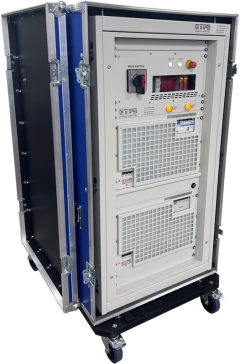
 Two G5-RSS-HC 80V modules are available in our rental range. These can be arranged in series or parallel configurations. Each module is able to operate independently, with inbuilt system comms allowing users to switch between various set-ups.
Two G5-RSS-HC 80V modules are available in our rental range. These can be arranged in series or parallel configurations. Each module is able to operate independently, with inbuilt system comms allowing users to switch between various set-ups. 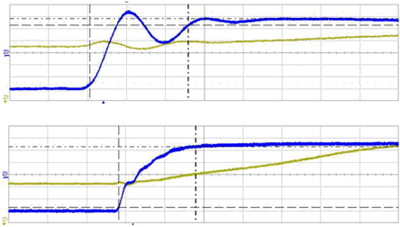 A current step between 90% sourcing to 90% sinking current can be as quick as 50µs, enabling high speed drives to be supplied. Advanced users have access to the controller settings enabling the response to be optimised for particular loads. This example shows a current step through quadrants. The upper trace shows the current transition is achieved in 50µs with a small overshoot before settling. The lower plot shows a more regulated response within 200µs. Voltage typically takes 100µs to recover within 0.5% of the set value. In multi-module systems the communication time between modules need to be considered.
A current step between 90% sourcing to 90% sinking current can be as quick as 50µs, enabling high speed drives to be supplied. Advanced users have access to the controller settings enabling the response to be optimised for particular loads. This example shows a current step through quadrants. The upper trace shows the current transition is achieved in 50µs with a small overshoot before settling. The lower plot shows a more regulated response within 200µs. Voltage typically takes 100µs to recover within 0.5% of the set value. In multi-module systems the communication time between modules need to be considered. By utilising the embedded function generator the user can set a current ripple at up to 10kHz. The magnitude can be up to 5% of the nominal system current. Depending on the impedance of the DUT the resulting voltage ripple can be calculated. The below example shows a 10kHz ripple generated using the function generator of the G5-RSS-HC. A peak to peak current of 8A has been superimposed on a current of 100A. Alternatively, a ripple can be implemented from an external waveform generator via the analogue interface using a proportional 0-10V signal.
By utilising the embedded function generator the user can set a current ripple at up to 10kHz. The magnitude can be up to 5% of the nominal system current. Depending on the impedance of the DUT the resulting voltage ripple can be calculated. The below example shows a 10kHz ripple generated using the function generator of the G5-RSS-HC. A peak to peak current of 8A has been superimposed on a current of 100A. Alternatively, a ripple can be implemented from an external waveform generator via the analogue interface using a proportional 0-10V signal. Sense plus terminals are built into the G5-RSS-HC for the connection of sense wire which compensates for voltage drops in the load lines. This has a number of advantages over traditional sense. It is permitted to interrupt the load line during operation (voltage on). The maximum voltage drop compensation is adjustable. The voltage difference between G5-RSS-HC output and sensing point is monitored. If a set limit is exceeded, the G5-RSS-HC unit shuts off. This is particularly useful for applications with long cables often prone to unwanted voltage drops.
Sense plus terminals are built into the G5-RSS-HC for the connection of sense wire which compensates for voltage drops in the load lines. This has a number of advantages over traditional sense. It is permitted to interrupt the load line during operation (voltage on). The maximum voltage drop compensation is adjustable. The voltage difference between G5-RSS-HC output and sensing point is monitored. If a set limit is exceeded, the G5-RSS-HC unit shuts off. This is particularly useful for applications with long cables often prone to unwanted voltage drops.  Every G5-RSS-HC features an autoranging output. This allows many more voltage/current combinations at nominal power than a traditional bidirectional DC power system. An example of the difference is shown below using a single G5-RSS 54-1000-162 module.
Every G5-RSS-HC features an autoranging output. This allows many more voltage/current combinations at nominal power than a traditional bidirectional DC power system. An example of the difference is shown below using a single G5-RSS 54-1000-162 module.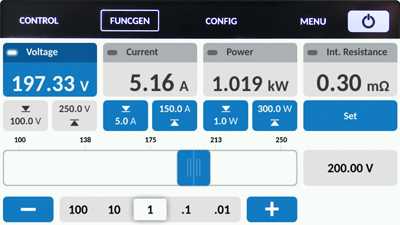 Each module has an HMI which provides a simple and intuitive way of control and measurement via a touchscreen panel. Users can directly access features such as the system's protections, warnings/errors and function generator without the use of a computer. A user defined passcode can be set to lock the touch screen, which prevents unauthorised access. When selected, the HMI replaces the front panel indicator.
Each module has an HMI which provides a simple and intuitive way of control and measurement via a touchscreen panel. Users can directly access features such as the system's protections, warnings/errors and function generator without the use of a computer. A user defined passcode can be set to lock the touch screen, which prevents unauthorised access. When selected, the HMI replaces the front panel indicator.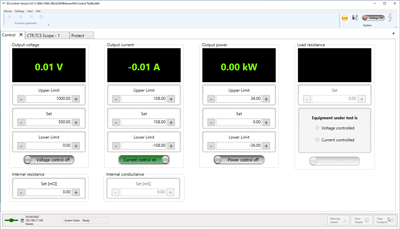 All G5-RSS-HC units come with a simple and intuitive G5.Control operating GUI as standard. Live values of the power system are displayed graphically along with any warning and error messages. The software provides a variety of second level parameters, ideal for users who like to optimise their test processes. In standard user mode the operator can remotely program set values, enable voltage output as well as the ability to analyse different variables including set and actual values via the integrated scope.
All G5-RSS-HC units come with a simple and intuitive G5.Control operating GUI as standard. Live values of the power system are displayed graphically along with any warning and error messages. The software provides a variety of second level parameters, ideal for users who like to optimise their test processes. In standard user mode the operator can remotely program set values, enable voltage output as well as the ability to analyse different variables including set and actual values via the integrated scope.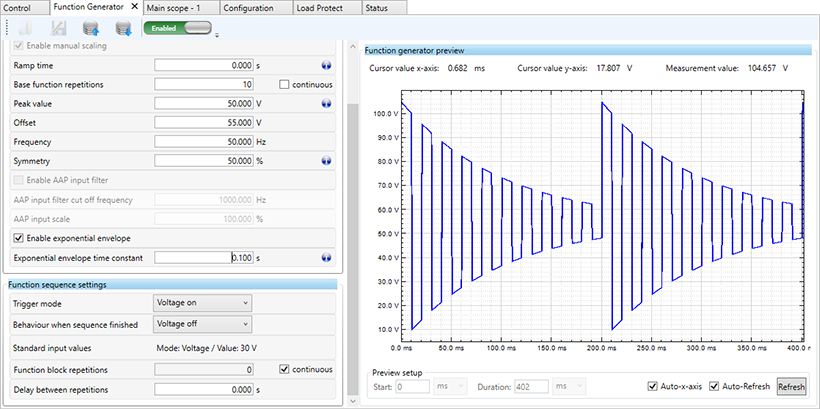
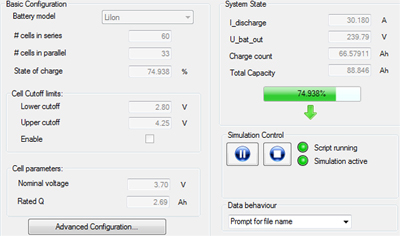 BatSim is a battery emulation GUI for use with G5-RSS-HC power systems. The GUI allows the power supplies to simulate real world behaviour of a battery pack.
BatSim is a battery emulation GUI for use with G5-RSS-HC power systems. The GUI allows the power supplies to simulate real world behaviour of a battery pack.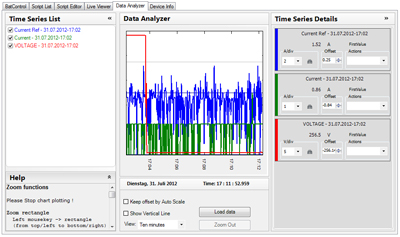 Drive cycle tests can be implemented using BatControl. The GUI’s main screen provides an overview of the main test values for all BatControl operations. Live data from the connected power system is displayed, and setting/adjustment of primary values is possible.
Drive cycle tests can be implemented using BatControl. The GUI’s main screen provides an overview of the main test values for all BatControl operations. Live data from the connected power system is displayed, and setting/adjustment of primary values is possible. 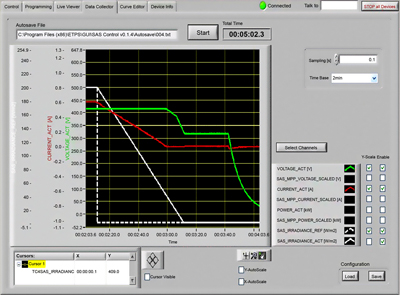 SASControl software has all EN 50530 tests pre-installed, with minor adaptations possible for particular inverter models. The GUI allows users to edit irradiance, temperature, amplitude values or input scaling with special commands.
SASControl software has all EN 50530 tests pre-installed, with minor adaptations possible for particular inverter models. The GUI allows users to edit irradiance, temperature, amplitude values or input scaling with special commands. 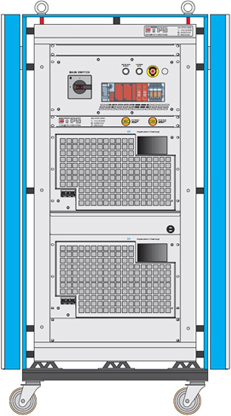 When renting 2x G5-RSS-HC modules a cabinet integration is used to make deployment simpler, quicker and safer in master/slave. Among the cabinet safety features is a status indicator that alerts users of any residual energy on the DC link that is greater than 30V. This operates even if the mains power is turned off. Another indicator assesses the quality and correct rotation of the AC input voltage and illuminates if correct.
When renting 2x G5-RSS-HC modules a cabinet integration is used to make deployment simpler, quicker and safer in master/slave. Among the cabinet safety features is a status indicator that alerts users of any residual energy on the DC link that is greater than 30V. This operates even if the mains power is turned off. Another indicator assesses the quality and correct rotation of the AC input voltage and illuminates if correct. A potential side effect of charger circuits that contain both AC and DC components is electrical noise. The ripple causes unwanted fluctuations in battery temperature, which results in deterioration of the battery’s performance. By utilising the G5-RSS-HC's embedded function generator the user can set a current ripple at up to 10kHz to simulate this phenomenon.
A potential side effect of charger circuits that contain both AC and DC components is electrical noise. The ripple causes unwanted fluctuations in battery temperature, which results in deterioration of the battery’s performance. By utilising the G5-RSS-HC's embedded function generator the user can set a current ripple at up to 10kHz to simulate this phenomenon.  Electrical components within a vehicle's subsystem must be able to withstand a wide range of input voltage surges and drops during a start-up. The G5-RSS-HC can accurately recreate these conditions within a lab environment. This increases reproducibility and accuracy of results when compared to using real batteries. Hard to replicate conditions such as voltage cranking during a cold start can be achieved. Voltage/current and voltage/power relationships can be programmed against time where necessary.
Electrical components within a vehicle's subsystem must be able to withstand a wide range of input voltage surges and drops during a start-up. The G5-RSS-HC can accurately recreate these conditions within a lab environment. This increases reproducibility and accuracy of results when compared to using real batteries. Hard to replicate conditions such as voltage cranking during a cold start can be achieved. Voltage/current and voltage/power relationships can be programmed against time where necessary.  Pulse charging interrupts the traditional DC charging curve with short relaxation periods. The technique is thought to improve battery discharge capacity and help facilitate longer cycle life. Some studies have shown that pulse charging is also helpful in eliminating concentration polarisation. The G5-RSS-HC's embedded function generator allows the PSU to deliver short burst of highly concentrated energy at user defined time intervals. The technique can also be used for powering lasers, electromagnets and plasma generation.
Pulse charging interrupts the traditional DC charging curve with short relaxation periods. The technique is thought to improve battery discharge capacity and help facilitate longer cycle life. Some studies have shown that pulse charging is also helpful in eliminating concentration polarisation. The G5-RSS-HC's embedded function generator allows the PSU to deliver short burst of highly concentrated energy at user defined time intervals. The technique can also be used for powering lasers, electromagnets and plasma generation.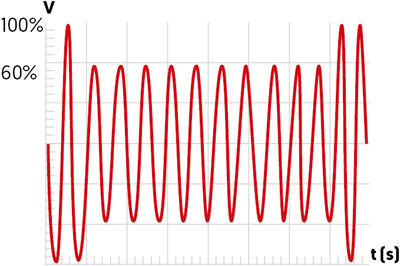 In electronic systems sudden voltage interruptions may cause unexpected behaviour. Supply line disturbances may have several causes, including an additional switch on of large capacitive loads parallel to the supply line or a short circuit caused by loads sharing the supply. The G5-RSS-HC can generate many complex DC waveforms to test devices under realistic conditions to identify any potential issues.
In electronic systems sudden voltage interruptions may cause unexpected behaviour. Supply line disturbances may have several causes, including an additional switch on of large capacitive loads parallel to the supply line or a short circuit caused by loads sharing the supply. The G5-RSS-HC can generate many complex DC waveforms to test devices under realistic conditions to identify any potential issues. The DC input of virtually any power conversion device can be replicated. The influence that variables, such as line voltage variation, have on performance can be isolated and tested. This allows optimum operating conditions to be characterised to improve efficiency and performance.
The DC input of virtually any power conversion device can be replicated. The influence that variables, such as line voltage variation, have on performance can be isolated and tested. This allows optimum operating conditions to be characterised to improve efficiency and performance. The discharge behaviour of an FCEV's fuel cell is often irregular. By using the function generator, both conservative and aggressive driver profiles can be replicated. This allows the G5-RSS-HC to perform effective quality testing of fuel cell powered components under all likely operating conditions.
The discharge behaviour of an FCEV's fuel cell is often irregular. By using the function generator, both conservative and aggressive driver profiles can be replicated. This allows the G5-RSS-HC to perform effective quality testing of fuel cell powered components under all likely operating conditions.


